Antiepileptic, hypocholesterolemic and neuroprotective compound
- Summary
- Abstract
- Description
- Claims
- Application Information
AI Technical Summary
Benefits of technology
Problems solved by technology
Method used
Image
Examples
example 1
Synthesis of (1S,2S,6R,8S,8aR)-1,2,6,7,8,8a-hexahydro-3,7-dimethyl-8-[2-[(2R,4R)-tetrahydro-4-hydroxy-6-oxo-2H-pyran-2-yl]ethyl]-1-naphthalenyl-2-ethyl-butyrate
[0150]The compound identified as NST0037 was prepared following the methodology described in Hoffman, et al. (J. Med. Chem., 1986, 29, 849-852) for similar compounds.
1.1. Purification of Lovastatin
[0151]Lovastatin was purified from an extract of natural origin by column chromatography using a hexane and ethyl acetate gradient as eluent.
1.2. Obtaining Monacolin J
[0152]
[0153]A solution of 0.7 g of potassium hydroxide in 0.5 ml of water is prepared and 3 ml of methanol are added little by little. 0.5 g of Lovastatin are subsequently added and the solution is placed under reflux for 21 hours. After the treatment of the reaction, a 50% mixture of monacolin J and the opened product is obtained.
1.3. Preparation of Protected Derivative
[0154]
[0155]A solution of 0.5 g of Monacolin J in 10 ml of dichloromethane is prepared. 0.4345 g of ...
example 2
Protection by NST0037 Against Neuronal Death Induced by Different Aggressions
Oxidative Stress, Endoplasmic Reticulum Stress and Apoptosis
2.1. Protection by NST0037 Against Neuronal Death Induced by Oxidative Stress
[0160]The assay was performed on human neuroblastoma SK-N-MC cells in culture from the American Type Culture Collection (ATCC), in all cases strict rules of sterility were followed and the manipulation was performed in class II biological safety cabinets following European standard EN 12469. The cells were maintained in the following culture medium: Minimum Essential Medium Eagle (MEM) supplemented with 1 mM sodium pyruvate, 2 mM L-glutamine, 0.1 mM non-essential amino acids, 0.05 mg / ml gentamicin and 10% fetal bovine serum.
[0161]The inhibition caused by compound NST0037 of cell death caused by treatment with xanthine / xanthine oxidase which generates oxidative damage (causes free radicals such as hydrogen peroxide, superoxide anion, hydroxyl radical), which triggers cell d...
example 3
Protection by NST0037 Against Neuronal Death in the Hippocampus, Against Cognitive Deficit and Against Death Caused by an Excitotoxic Substance
3.1. Protective Effect of NST0037 Against Neuronal Death in the Hippocampus of Mice Caused by an Excitotoxic Substance
[0194]Based on the results of Example 2, the inventors decided to investigate if the neuroprotective effect of NST0037 demonstrated in human cholinergic neurons was corroborated in a model of sporadic Alzheimer's disease in mice by means of the administration of kainate (KA).
[0195]All the animals included for the experimental process were 12-week old males of the FVB / NHan strain. The experiments were conducted strictly following the Guidance on the Operation of Animals (Scientific Procedures, Act. 1986). The animals had their respective quarantine period and were treated with maximum precaution to minimize possible contaminations for inoculations and handling.
[0196]Twenty-eight animals were used in this assay and the treatment...
PUM
| Property | Measurement | Unit |
|---|---|---|
| Fraction | aaaaa | aaaaa |
| Fraction | aaaaa | aaaaa |
| Fraction | aaaaa | aaaaa |
Abstract
Description
Claims
Application Information
 Login to View More
Login to View More - R&D
- Intellectual Property
- Life Sciences
- Materials
- Tech Scout
- Unparalleled Data Quality
- Higher Quality Content
- 60% Fewer Hallucinations
Browse by: Latest US Patents, China's latest patents, Technical Efficacy Thesaurus, Application Domain, Technology Topic, Popular Technical Reports.
© 2025 PatSnap. All rights reserved.Legal|Privacy policy|Modern Slavery Act Transparency Statement|Sitemap|About US| Contact US: help@patsnap.com



